Navigation
- Why does pain from breastfeeding happen?
- How to help relieve wrist pain or thumb pain (Mommy’s Thumb)
- Solutions for neck pain
- Yoga poses to try for upper back pain
- Why rib pain can occur and how to relieve it
- Shoulder pain and loss of posture
- Tight psoas muscle
- FAQs
When it comes to feeding your baby, you may have heard of the pains of cracked nipples or clogged ducts. (Please see a lactation consultant for those since it’s out of my scope to advise those!) But there can be other physical pain related to breastfeeding. For these, yoga to the rescue!
So why does pain from breastfeeding happen?
Why does pain from breastfeeding happen?
There are a number of reasons why pain from breastfeeding can happen. These include bad posture while feeding, repetitive movements as well pain from holding your baby for long periods of time.
This can result in pain in different parts of your body.
Let’s review some of the different aches and pains and give you some solid solutions to these issues so you can feed your baby with more comfort and ease!
- Wrist pain/ thumb pain
- Tight neck
- Headaches
- Upper back pain
- Rib pain
- Shoulder pain and general feeling like they are losing their posture
- Tight psoas and hip pain from all the sitting
How to help relieve wrist pain or thumb pain (Mommy Thumb)
- This is sometimes called “Mommy thumb”. The tendons around the thumb can be swollen and painful and the pain is felt at the base of the thumb right above the wrist. Both bottle and breastfeeding parents can get this from the repetitive movement of holding the baby while feeding .
SOLUTION: Nerve flossing is where we mobilize and stretch the nerve. This also brings circulation to the nerve to help with healing and reduces pain.
Solutions for neck pain
- SOLUTION: check your posture. As your shoulders round forward, the head shifts into what I call, “The chicken neck”. This is where the chin shifts forward. This elongates and weakens the neck muscles which can also lead to headaches and jaw tension.
- So in class we look at aligning posture. Let me take a brief digression to remind you there is no such thing as “perfect posture”. We are looking to align your head over your spine, stack your ribs over your pelvis. Balance the pelvis which oftentimes is either overly tipped forward or tucked under and back, move your thigh bones back and be balanced on the four corners of your feet. I call this ”back it up and stack it up”!
- Let’s continue down the path of releasing a tight neck. We also want to strengthen the upper back and release and massage the neck muscles.
Yoga poses to try for upper back pain
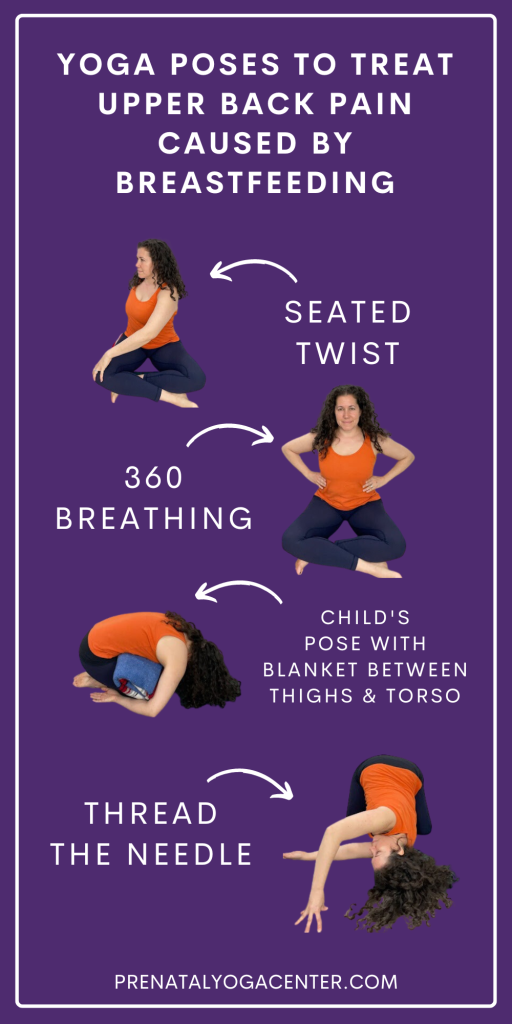
For upper back pain, there are a number of different yoga poses that will help to relieve it.
Generally, upper back mobility, good breathing, twists as well as maintaining good posture will help to treat back pain.
Here are a few of my favorite yoga poses that will address upper pain.
Seated Twist
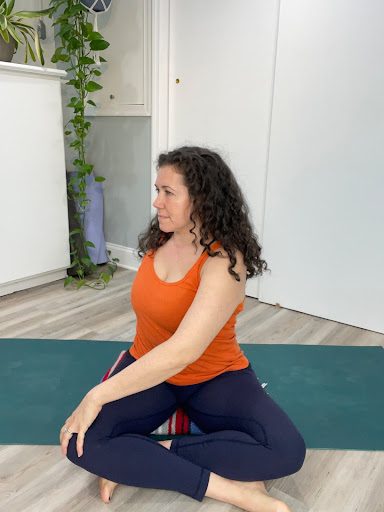
360 Breathing
Read more about 360 Breathing in our blog post: How Prenatal Yoga Can Help You To Have an Easier Birth
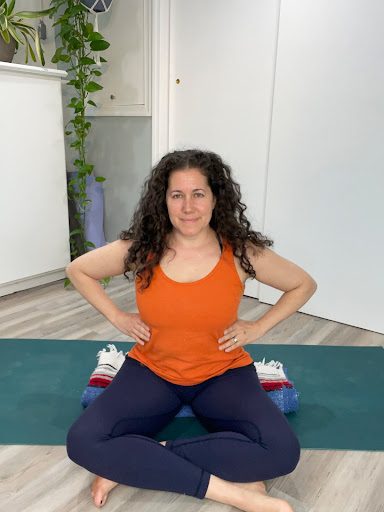
Child’s Pose With Blanket Between Thighs And Torso
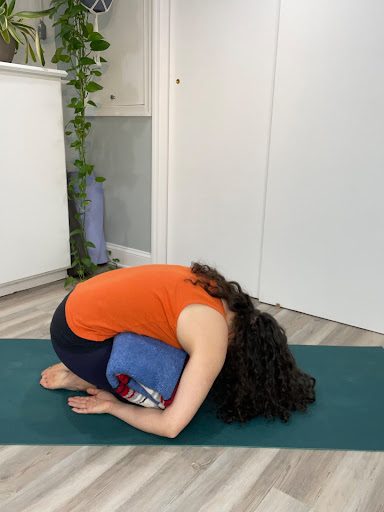
Thread the Needle Pose
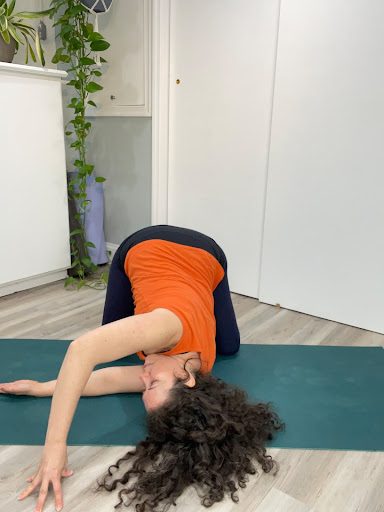
Why rib pain can occur and how to relieve it
Did you know your rib cage can expand up to 6 cm in circumference by the end of pregnancy? Some of your rib cage pain can be a result of the intercostal muscles (those tiny muscles between the ribs) expanding. Or from the confinement of an ill-fitted, tight bra and you guessed it, posture.
If your chest is caved in or the ribs are flaring forward, the rib cage can not expand evenly when breathing.
Solution:
- Ditch the tight bra!
- Add some side stretches and rotation to your daily movement practice!
Side stretching is a great way to open and stretch your intercostal muscles (the small muscles between the ribs that help with respiration). Add some rib cage rotation and we can help release tight muscles in the upper mid back as well!
- Practice 360 breathing which will help you expand the full circumference of your rib cage.
Shoulder pain and loss of posture
If you are experiencing shoulder pain and a general feeling of losing your posture, then you most likely need more support during feeds.
- SOLUTION: Make sure you have good support when feeding. Is there something to support the baby and their arm? We don’t want to bring the breast to the baby, bring the baby to the breast!
Tight Psoas Muscle
The psoas is a muscle that runs from T12, the 12th thoracic vertebrae, down the spine over the pelvic brim and attaches to the lesser trochanter of the femur (your thigh bone). This muscle, for so many bodies, is tight and often picks up the slack of weak pelvic floor muscles, weak abdominals and weak hip rotates.
- Solution: One of my favorite ways to release the psoas is a passive with 360 breathing and child’s pose.
For those in the grip of early postpartum, I hope these yoga poses can help. While we practice these poses in postnatal and Baby and Me yoga class, you can still reap the benefits from simply carving out 10 minutes a day for a quick and effective practice!
Book one of our Postnatal Yoga or Baby and Me Yoga classes by clicking the button below!
FAQs
Is it normal for joints to hurt while breastfeeding?
Due to hormonal changes, joints may feel achy. However, when a student shares this complaint week after week in class, I always advise them to check in with their care provider. This could be a sign of thyroid issues, which is very common postpartum.
Can yoga help with pain from breastfeeding?
As I laid out in this article, there are many yoga poses that will help with the many aches and pain one feels as a result of feeding a baby.
What positions are best to reduce pain and discomfort while breastfeeding?
In the beginning, you may find it helpful to use a breastfeeding pillow for support so you are not hunched forward bringing your breast to the baby. You want to bring the baby to your breast, so having support will help your posture as well as lessen the strain of holding the weight of your baby for the whole feed.
As your baby gets bigger and breastfeeding is more established, you can try side lying feeding which many new parents feel can be more comfortable.
I also highly recommend working with a lactation consultant who can look at your posture and the support you are using for feeding your baby. You can also look for a local La Leche League meeting where a lactation consultant can help you.







